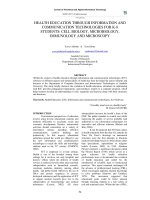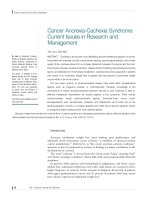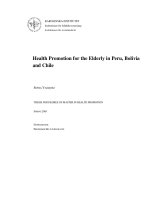GENOMICS AND PROTEOMICS ENGINEERING IN MEDICINE AND BIOLOGY ppt
Bạn đang xem bản rút gọn của tài liệu. Xem và tải ngay bản đầy đủ của tài liệu tại đây (9.2 MB, 316 trang )
GENOMICS AND
PROTEOMICS
ENGINEERING
IN MEDICINE
AND BIOLOGY
IEEE Press
445 Hoes Lane
Piscataway, NJ 08854
IEEE Press Editorial Board
Mohamed E. El-Hawary, Editor in Chief
J. B. Anderson S. V. Kartalopoulos N. Schulz
R. J. Baker M. Montrose C. Singh
T. G. Croda M. S. Newman G. Zobrist
R. J. Herrick F. M. B. Periera
Kenneth Moore, Director of IEEE Book and Information Services (BIS)
Catherine Faduska, Senior Acquisitions Editor
Steve Welch, Acquisitions Editor
Jeanne Audino, Project Editor
IEEE Engineering in Medicine and Biology Society, Sponsor
EMB-S Liaison to IEEE Press, Metin Akay
GENOMICS AND
PROTEOMICS
ENGINEERING
IN MEDICINE
AND BIOLOGY
Edited by
Metin Akay
IEEE Engineering in Medicine and Biology Society, Sponsor
Copyright # 2007 by the Institute of Electrical and Electronics Engineers, Inc. All rights reserved.
Published by John Wiley & Sons, Inc. Published simultaneously in Canada.
No part of this publication may be reproduced, stored in a retrieval system, or transmitted in any form
or by any means, electronic, mechanical, photocopying, recording, scanning, or otherwise, except as
permitted under Section 107 or 108 of the 1976 United States Copyright Act, without either the prior
written permission of the Publisher, or authorization through payment of the appropriate per-copy fee
to the Copyright Clearance Center, Inc., 222 Rosewood Drive, Danvers, MA 01923, (978) 750-8400,
fax(978)750-4470,orontheWebatwww.copyright.com.RequeststothePublisherforpermission
should be addressed to the Permissions Department, John Wiley & Sons, Inc., 111 River Street, Hoboken,
NJ 07030, (201) 748-6011, fax (201) 748-6008, or online at />Limit of Liability/Disclaimer of Warranty: While the publisher and author have used their best efforts
in preparing this book, they make no representations or warranties with respect to the accuracy or com-
pleteness of the contents of this book and specifically disclaim any implied warranties of merchantability
or fitness for a particular purpose. No warranty may be created or extended by sales representatives or
written sales materials. The advice and strategies contained herein may not be suitable for your situation.
You should consult with a professional where appropriate. Neither the publisher nor author shall be liable
for any loss of profit or any other commercial damages, including but not limited to special, incidental,
consequential, or other damages.
For general information on our other products and services or for technical support, please contact our
Customer Care Department within the United States at (800) 762-2974, outside the United States at
(317) 572-3993 or fax (317) 572-4002.
Wiley also publishes its books in a variety of electronic formats. Some content that appears in print may
not be available in electronic formats. For more information about Wiley products, visit our Web site at
www.wiley.com.
Library of Congress Cataloging-in-Publication Data is available
ISBN-13 978-0-471-63181-1
ISBN-10 0-471-63181-7
Printed in the United States of America
10987654321
To the memory of my late brother, C¸ etin Akay, who dedicated his short but meaningful life to
the well-being and happiness of others as well as a democratic and secular Turkey.
May God bless his soul.
&
CONTENTS
Preface xi
Contributors xiii
1. Qualitative Knowledge Models in Functional Genomics
and Proteomics 1
Mor Peleg, Irene S. Gabashvili, and Russ B. Altman
1.1. Introduction 1
1.2. Methods and Tools 3
1.3. Modeling Approach and Results 6
1.4. Discussion 19
1.5. Conclusion 20
References 21
2. Interpreting Microarray Data and Related Applications
Using Nonlinear System Identification 25
Michael Korenberg
2.1. Introduction 25
2.2. Background 25
2.3. Parallel Cascade Identification 30
2.4. Constructing Class Predictors 34
2.5. Prediction Based on Gene Expression Profiling 35
2.6. Comparing Different Predictors Over the Same Data Set 46
2.7. Concluding Remarks 48
References 49
3. Gene Regulation Bioinformatics of Microarray Data 55
Gert Thijs, Frank De Smet, Yves Moreau, Kathleen Marchal,
and Bart De Moor
3.1. Introduction 55
3.2. Introduction to Transcriptional Regulation 57
3.3. Measuring Gene Expression Profiles 59
3.4. Preprocessing of Data 61
3.5. Clustering of Gene Expression Profiles 63
vii
3.6. Cluster Validation 70
3.7. Searching for Common Binding Sites of Coregulated Genes 76
3.8. Inclusive: Online Integrated Analysis of Microarray Data 87
3.9. Further Integrative Steps 89
3.10. Conclusion 90
References 91
4. Robust Methods for Microarray Analysis 99
George S. Davidson, Shawn Martin, Kevin W. Boyack, Brian N. Wylie,
Juanita Martinez, Anthony Aragon, Margaret Werner-Washburne,
Mo
´
nica Mosquera-Caro, and Cheryl Willman
4.1. Introduction 99
4.2. Microarray Experiments and Analysis Methods 100
4.3. Unsupervised Methods 103
4.4. Supervised Methods 117
4.5. Conclusion 127
References 128
5. In Silico Radiation Oncology: A Platform for Understanding
Cancer Behavior and Opt imizing Radiation Therapy Treatment 131
G. Stamatakos, D. Dionysiou, and N. Uzunoglu
5.1. Philosophiae Tumoralis Principia Algorithmica: Algorithmic
Principles of Simulating Cancer on Computer 131
5.2. Brief Literature Review 133
5.3. Paradigm of Four-Dimensional Simulation of Tumor Growth
and Response to Radiation Therapy In Vivo 135
5.4. Discussion 148
5.5. Future Trends 150
References 150
6. Genomewide Motif Identification Using a Dictionary Model 157
Chiara Sabatti and Kenneth Lange
6.1. Introduction 157
6.2. Unified Model 160
6.3. Algorithms for Likelihood Evaluation 164
6.4. Parameter Estimation via Minorization–Maximization Algorithm 167
6.5. Examples 170
6.6. Discussion and Conclusion 171
References 172
7. Error Control Codes and the Genome 173
Elebeoba E. May
7.1. Error Control and Communication: A Review 173
viii CONTENTS
7.2. Central Dogma as Communication System 180
7.3. Reverse Engineering the Genetic Error Control System 184
7.4. Applications of Biological Coding Theory 203
References 205
8. Complex Life Science Multidatabase Queries 209
Zina Ben Miled, Nianhua Li, Yue He, Malika Mahoui, and Omran Bukhres
8.1. Introduction 209
8.2. Architecture 212
8.3. Query Execution Plans 214
8.4. Related Work 219
8.5. Future Trends 222
References 223
9. Computational Analysis of Proteins 227
Dimitrios I. Fotiadis, Yorgos Goletsis, Christos Lampros,
and Costas Papaloukas
9.1. Introduction: Definitions 227
9.2. Databases 229
9.3. Sequence Motifs and Domains 232
9.4. Sequence Alignment 235
9.5. Modeling 241
9.6. Classification and Prediction 242
9.7. Natural Language Processing 248
9.8. Future Trends 252
References 252
10. Computational Analysis of Interactions Between Tumor and
Tumor Suppressor Proteins 257
E. Pirogova, M. Akay, and I. Cosic
10.1. Introduction 257
10.2. Methodology: Resonant Recognition Model 261
10.3. Results and Discussions 265
10.4. Conclusion 284
References 285
Index 289
About the Editor 299
CONTENTS ix
&
PREFACE
The biological sciences have become more quantitative and information-driven
since emerging computational and mathematical tools facilitate collection and
analysis of vast amounts of biological data. Complexity analysis of biological
systems provides biological knowledge for the organization, management, and
mining of biological data by using advanced computational tools. The biological
data are inherently complex, nonuniform, and collected at multiple temporal and
spatial scales. The investigations of complex biological systems and processes
require an extensive collaboration among biologists, mathematicians, computer
scientists, and engineers to improve our understanding of complex biological
process from gene to system. Lectures in the summer school expose attendees to
the latest developments in these emerging computational technologies and facilitate
rapid diffusion of these mathematical and computational tools in the biological
sciences. These computational tools have become powerful tools for the study of
complex biological systems and signals and can be used for characterizing variabil-
ity and uncertainty of biological signals across scales of space and time since the
biological signals are direct indicators of the biological state of the corresponding
cells or organs in the body.
The integration and application of mathematics, engineering, physics and compu-
ter science have been recently used to better understand the complex biological
systems by examining the structure and dynamics of cell and organ functions.
This emerging field called “Genomics and Proteomics Engineering” has gained
tremendous interest among molecular and cellular researchers since it provides a
continuous spectrum of knowledge. However, this emerging technology has not
been adequately presented to biological and bioengineering researc hers. For this
reason, an increasing demand can be found for interdisciplinary interactions
among biologists, engineers, mathematicians, computer scientists and medical
researchers in these emerging technologies to provide the impetus to understand
and develop reliable quantitative answers to the major integrative biological and
biomedical challenges.
The main objective of this edited book is to provide information for biological
science and biomedical engineering students and researchers in genomics and pro-
teomics sciences and systems biology. Although an understanding of genes and
proteins are important, the focus is on understanding a system’s structure and
dynamics of several gene regulatory networks and their bioc hemical interactions.
xi
System-level understanding of biology is derived using mathematical and engineer-
ing methods to understand complex biological processes. It exposes readers with
biology background to the latest developments in proteomics and genomics engin-
eering. It also addresses the needs of both students and postdoctoral fellows in com-
puter science and mathematics who are interested in doing research in biology and
bioengineering since the book provides exceptional insights into the fundamental
challenges in biology.
I am grateful to Jeanne Audino of the IEEE Press and Lisa Van Horn of Wiley for
their help during the editing of this book. Working in conce rt with them and the con-
tributors really helped me with content development and to manage the peer-review
process.
Finally, many thanks to my wife, Dr. Yasemin M. Akay, and our son, Altug R.
Akay, for their support, encouragement, and patience. They have been my driving
source. I also thank Jeremy Romain for his help in rearranging the chapters and
getting the permission forms from the contributors.
M
ETIN AKAY
Tempe, Arizona
September 2006
xii
PREFACE
&
CONTRIBUTORS
Metin Akay, Har rington Department of Bioengineering, Fulton School of Engin-
eering, Arizona State University, Tempe, Arizona
Russ B. Altman, Stanf ord Medical Informatics, Stanford University, Stanford,
California
Anthony Aragon, Department of Biology, University of New Mexico,
Albuquerque, New Mexico
Zia Ben Miled Electrical and Computer Engineering, Purdue School of Engineer-
ing and Technology, IUPUI, Indianapolis, Indiana
Kevin W. Boyack, Computation, Computers, Information and Mathematics,
Sandia National Laboratories, Albuquerque, New Mexico
Omran Bukhres Department of Computer and Information Science, IUPUI,
Indianapolis, Indiana
I. Cosic, School of Electrical and Computer Engineering, RMIT University,
Melbourne, Australia
George S. Davidson, Computation, Computers, Information and Mathematics,
Sandia National Laboratories, Albuquerque, New Mexico
Bart De Moor, Department of Electrical Engineering (ESAT-SCD), Katholieke
Universiteit Leuven, Leuven, Belgium
Frank De Smet, Department of Electrical Engineering (ESAT-SCD), Katholieke
Universiteit Leuven, Leuven, Belgium
D. Dionysiou, In Silico Oncology Group, Laboratory of Microwaves and Fiber
Optics, Institute of Communication and Computer Systems, Department of
Electrical and Computer Engineering, National Technical University of Athens,
Zografos, Greece
Dimitrios I. Fotiadis, Unit of Medical Technology and Intelligent Information
Systems, Department of Computer Science, University of Ioannina, Ionnina, Greece
Irene S. Gabashvili, Hewlett Packard Labs, Palo Alto, California
Yorgos Goletsis, Unit of Medical Technology and Intelligent Information Systems,
Department of Computer Science, University of Ioannina, Ionnina, Greece
xiii
Yue He Electrical and Computer Engineering, Purdue School of Engineering and
Technology, IUPUI, Indianapolis, Indiana
Michael Korenberg, Department of Electrical and Computer Engineering,
Queen’s University, Kingston, Ontario, Canada
Christos Lampros, Unit of Medical Technology and Intelligent Information
Systems, Department of Computer Science, University of Ioannina, Ionnina,
Greece
Kenneth Lange, Biomathematics, Human Genetics, and Statistics Department,
University of California at Los Angeles, Los Angeles, California 90095
Nianhua Li Electrical and Computer Engineering, Purdue School of Engineering
and Technology, IUPUI, Indianapolis, Indiana
Malika Mahoui School of Informatics, IUPUI, Indianapolis, Indiana
Kathleen Marchal, Department of Electrical Engineering (ESAT-SCD),
Katholieke Universiteit Leuven, Leuven, Belgium
Shawn Martin, Computation, Computers, Information and Mathematics, Sandia
National Laboratories, Albuquerque, New Mexico
Juanita Martinez, Department of Biology, University of New Mexico,
Albuquerque, New Mexico
Elebeoba E. May, Computational Biology Department, Sandia National
Laboratories, Albuquerque, New Mexico
Yves Moreau, Department of Electrical Engineering (ESAT-SCD), Katholieke
Universiteit Leuven, Leuven, Belgium
Monica Mosquera-Caro, Cancer Research and Treatment Center, Department of
Pathology, University of New Mexico, Albuquerque, New Mexico
Costas Papaloukas, Unit of Medical Technology and Intelligent Information
Systems, Department of Computer Science, University of Ioannina, Ionnina,
Greece
Mor Peleg, Department of Management Information Systems, University of Haifa,
Israel
E. Pirogova, School of Electrical and Computer Engineering, RMIT University,
Melbourne, Australia
Chiara Sabatti, Human Genetics and Statistics Department, University of
California at Los Angeles, Los Angeles, California
G. Stamatakos, In Silico Oncology Group, Laboratory of Microwaves and Fiber
Optics, Institute of Communication and Computer Systems, Department of
Electrical and Computer Engineering, National Technical University of Athens,
Zografos, Greece
xiv CONTRIBUTORS
Gert Thijs , Department of Electrical Engineering (ESAT-SCD), Katholieke
Universiteit Leuven, Leuven, Belgium
N. Uzunoglu, In Silico Oncolog y Group, Laboratory of Microwaves and Fiber
Optics, Institute of Communication and Computer Systems, Department of
Electrical and Computer Engineering, National Technical University of Athens,
Zografos, Greece
Margaret Werner-Washburne, Department of Biology, University of New
Mexico, Albuquerque, New Mexico
Cheryl Willman, Cancer Research and Treatment Center, Department of
Pathology, University of New Mexico, Albuquerque, New Mexico
Brian N. Wylie, Computation, Computers, Information and Mathematics, Sandi a
National Laboratories, Albuquerque, New Mexico
CONTRIBUTORS xv
&
CHAPTER 1
Qualitative Knowledge Models in
Functional Genomics and
Proteomics
MOR PELEG, IRENE S. GABASHVILI, and RUSS B. ALTMAN
1.1. INTRODUCTION
Predicting pathological phenotypes based on genetic mutations remains a
fundamental and unsolved issue. When a gene is mutated, the molecular function-
ality of the gene product may be affected and many cellular processes may go
awry. Basic molecular functions occur in networks of interactions and events that
produce subsequent cellular and physiological functions. Most knowledge of
these interactions is represented diffusely in the published literature, Excel lists,
and specializ ed relational databases and so it is difficult to assess our state of under-
standing at any moment. Thus it would be very useful to systematically store knowl-
edge in data structures that allow the knowledge to be evaluated and examined in
detail by scientists as well as computer algorithms. Our goal is to develop technol-
ogy for representing qualitative, noisy, and sparse biological results in support of the
eventual goal of fully accurate quantitative models.
In a recent paper, we described an ontology that we developed for modeling bio-
logical processes [1]. Ontologies provide consistent definitions and interpretations
of concepts in a domain of interest (e.g., biology) and enable software applications
to share and reuse the knowledge consistently [2]. Ontologies can be used to perform
logical inference over the set of concepts to provide for generalization and expla-
nation facilities [3]. Our biological process ontology combines and extends two
existing components: a workflow model and a biomedical ontology, both described
in the methods and tools section. Our resulting framework possesses the following
properties: (1) it allows qualitative modeling of structural and functional aspects of a
biological system, (2) it includes biological and medical concept models to allow for
querying biomedical information using biomedical abstractions, (3) it allows
1
Genomics and Proteomics Engineering in Medicine and Biology. Edited by Metin Akay
Copyright # 2007 the Institute of Electrical and Electronics Engineers, Inc.
hierarchical models to manage the complexity of the representation, (4) it has a
sound logical basis for automatic verification, and (5) it has an intuitive, graphical
representation.
Our application domain is disease related to transfer ribonucleic acid (tRNA).
Transfer RNA constitutes a good test bed because there exists rich literature on
tRNA molecular structure as well as the diseases that result from abnormal struc-
tures in mitochondria (many of which affect neural proce sses). The main role of
tRNA molecules is to be part of the machinery for the translation of the genetic
message, encoded in messenger RNA (mRNA), into a protein. This process
employs over 20 different tRNA molecules, each specific for one amino acid and
for a particular triplet of nucleotides in mRNA (codon) [4]. Several steps take
place before a tRNA molecule can participate in translation. After a gene coding
for tRNA is transcribed, the RNA product is folded and processed to become a
tRNA molecule. The tRNA molecules are covalently linked (acylated) with an
amino acid to form amino-acylated tRNA (aa-tRNA). The aa-tRNA molecules
can then bind with translation factors to form complexes that may participate in
the translation process. There are three kinds of complexes that participate in trans-
lation: (i) an initiation complex is formed by exhibiting tRNA mimicry release
factors that bind to the stop codon in the mRNA template or by a misfunctioning
tRNA complexed with guanidine triphosphate (GTP) and elongation factor
causing abnormal termination, and (iii) a ternary complex is formed by binding
elongating aa-tRNAs (tRNAs that are acylated to amino acids other than formyl-
methionine) with GTP and the elongation factor EF-tu. During the translation
process, tRNA molecules recognize the mRNA codons one by one, as the mRNA
molecule moves through the cellular machine for protein synthesis: the ribosome.
In 1964, Watson introduced the classical two-site model, which was the accepted
model until 1984 [5]. In this model, the ribosome has two regions for tRNA
binding, so-called aminoacyl (A) site and peptidyl (P) site. According to this
model, initiation starts from the P site, but during the normal cycle of elongation,
each tRNA enters the ribosome from the A site and proceeds to the P site before
exiting into the cell’s cytoplasm. Currently, it is hypothesized that the ribosome
has at least three regions for tRNA binding: the A and P sites and an exit site
(E site) through which the tRNA exits the ribosome into the cell’s cytoplasm [6].
Protein synthesis is terminated when a stop codon is reached at the ribosomal A
site and recognized by a specific termination complex, probably involving factors
mimicking tRNA. Premature termination (e.g., due to a mutation in tRNA) can
also be observed [7].
When aa-tRNA molecules bind to the A site, they normally recognize and bind to
matching mRNA codons—a process known as reading. The tRNA mutations can
cause abnormal reading that leads to mutated protein products of translation.
Types of abnormal reading include (1) misreading, where tRNA with nonmatching
amino acid binds to the ribosome’s A site; (2) frame shifting, where tRNA that
causes frame shifting (e.g., binds to four nucleotides of the mRNA at the A site) par-
ticipates in elongation; and (3) halting, where tRNA that cause premature termin-
ation (e.g., tRNA that is not acetylated with an amino acid) binds to the A site.
2 QUALITATIVE KNOWLEDGE MODELS IN FUNCTIONAL GENOMICS AND PROTEOMICS
These three types of errors, along with the inability to bind to the A site or destruc-
tion by cellular enzymes due to misfolding, can create comp lex changes in protein
profiles of cells. This can affect all molecular partners of produced proteins in the
chain of events connecting genotype to phenotype and produce a variety of pheno-
types. Mutations in human tRNA molecules have been implicated in a wide range of
disorders, including myopathies, encephalopathies, cardiopathies, diabetes, growth
retardation, and aging [8]. Development of models that consolidate and integrate
our understanding of the molecular foundations for these diseases, based on avail-
able structural, biochemical, and physiological knowledge, is therefore urgently
needed.
In a recent paper [9], we discussed an application of our biological process ontol-
ogy to genomics and proteomics. This chapter extends the section on general com-
puter science theories, including Petri Nets, ontologies, and information systems
modeling methodologies, as well as extends the section on biological sources of
information and discusses the compatibility of our outputs wi th popular databases
and modeling environments.
The chapter is organized as follows. Section 1.2 describes the components we
used to develop the framework and the knowledge sources for our model. Section
1.3 discusses our modeling approach and demonstrates our knowledge model and
the way in which information can be viewed and queried using the process of trans-
lation as examples. We conclude with a discussion and conclusion.
1.2. METHODS AND TOOLS
1.2.1. Component Ontologies
Our framework combine s and extends two existing components: The workflow
model and biomedical ontology. The workflow model [10] consists of a process
model and an organiza tional (participants/role) model. The proce ss model can rep-
resent ordering of processes (e.g., protein translation) and the structural components
that participate in them (e.g., protein). Processes may be of low granularity (high-
level processe s) or of high granularity (low-level processes). High-level processes
are nested to control the complexity of the presentation for human inspection.
The participants/role model represents the relationships among participants (e.g.,
an EF-tu is a member of the elongation factors collection in prokaryotes) and the
roles that participants play in the modeled processes (e.g., EF-tu has enzymic func-
tion: GTPase). We used the workflow model as a biological process model by
mapping workflow activities to biological processes, organizational units to bio-
molecular complexes, humans (individuals) to their biopolymers and networks of
events, and roles to biological processes and functions.
A significant advantage of the workflow model is that it can map to Petri Nets
[11], a mathematical model that represents concurrent systems, which allows veri-
fication of formal properties as well as qualitative simulation [12]. A Petri Net is
represented by a directed, bipartite graph in which nodes are either places or
1.2. METHODS AND TOOLS 3
transitions, where places represent conditions (e.g., parasite in the bloodstream) and
transitions represent activities (e.g., inva sion of host erythrocytes). Tokens that are
placed on places define the state of the Petri Net (marking). A token that resides in a
place signifies that the condition that the place repr esents is true. A Petri Net can be
executed in the following way. When all the places with arcs to a transition have a
token, the transition is enabled, and may fire, by removing a token from each input
place and adding a token to each place pointed to by the transition. High-level Petri
Nets, used in this work, include extensions that allow modeling of time, data, and
hierarchies.
For the biomedical ontology, we combine the Transparent Access to Multiple
Biological Information Sources (TAMBIS) [13] with the Unified Medical Language
System (UMLS) [14]. TAMBIS is an ontology for describing data to be obtained
from bioinformatics sources. It describes biological entities at the molecular level.
UMLS describ es clinical and medical entities. It is a publicly available federation
of biomedical controlled terminologies and includes a semantic network with 134
semantic types that provides a consistent categorization of thousands of biomedical
concepts. The 2002AA edition of the UMLS Metathesaurus includes 776,940 con-
cepts and 2.1 million concept names in over 60 different biomedical source vocabul-
aries. We augmented these two core terminological models [1] to represent
mutations and their effects on biomolecular structures, biochemical functions, cellu-
lar processes, and clinical phenotypes. The extensions include classes for represent-
ing (1) mutations and alleles and their relationship to sequence components, (2) a
nucleic acid three-dimensional structure linked to secondary and primary structural
blocks, and (3) a set of composition operators, based on the nomenclature of com-
position relationships, due to Odell [15].
Odell introduced a nomenclature of six kinds of composition. We are using three
of these com position relationships in our model. The relationship between a biomo-
lecular complex (e.g., ternary complex) and its parts (e.g., GTP, EF-tu, aa-tRNA) is
a component –integral object composition. This relationship defines a configuration
of parts within a whole. A configuration requires the parts to bear a particular func-
tional or structural relationship to one another as well as to the object they constitute.
The relationship between an individual molecule (e.g., tRNA) and its domains (e.g.,
D domain, T domain) is a place –area composition. This relationship defines a con-
figuration of parts, where parts are the same kind of thing as the whole and the parts
cannot be separated from the whole. Member–bunch composition groups together
molecules into collections when the collection members share similar functionality
(e.g., elongation factors) or cellular location (e.g., membrane proteins). We have
not found the othe r three composition relationships due to Odell to be relevant for
our model.
We implemented our framework using the Prote
´
ge
´
-2000 knowledge-modeling
tool [16]. We used Prote
´
ge
´
’s axiom language (PAL) to define queries in a subset
of first-order predicate logic written in the Knowledge Interchange Format syntax.
The queries present, in tabular format, relationships among processes and structural
components as well as the relationship between a defective process or clinical phe-
notype and the mutation that is causing it.
4 QUALITATIVE KNOWLEDGE MODELS IN FUNCTIONAL GENOMICS AND PROTEOMICS
1.2.2. Translation into Petri Nets
We manually translated the tRNA workflow model into corresponding Petri Nets,
according to mapping defined by others [12]. The Petri Net models that we used
were high-level Petri Nets that allow the representation of hierarchy and data. Hier-
archies enable expanding a transition in a given Petri Net to an entire Petri Net, as is
done in expanding workflow high-level processes into a net of lower level processes.
We upgraded the derived Petri Nets to Colored Petri Nets (CPNs) by:
1. Defining color sets for tRNA molecules (mutated and normal), mRNA mol-
ecules, and nucleotides that comprise the mRNA sequence and initiating the
Petri Nets with an initial marking of colored tokens
2. Adding guards on transitions that relate to different types of tRNA molecules
(e.g., fMet-tRNA vs. elongating tRNA molecules)
3. Defining mRNA sequences that serve as the template for translation
We used the Woflan Petri Net verification tool [17] to verify that the Petri Nets
are bounded (i.e., no accumulation of an infinite amount of tokens) and live (i.e.,
deadlocks do not exist). To accommodate limitations in the Woflan tool, which
does not support colored Petri Nets, we manually made several minor changes to
the Petri Nets before verifying them. We simulated the Petri Nets to study the
dynamic aspects of the translation process using the Design CPN tool [18], which
has since been replaced by CPN Tools.
1.2.3. Sources of Biological Data
We gathered information from databases and published literature in order to develop
the tRNA example considered in this work. We identified data sources with infor-
mation pertaining to tRNA sequence, structure, modifications, mutations, and
disease associations. The databases that we used were:
.
Compilation of mammalian mitochondrial tRNA genes [19], aimed at defining
typical as well as consensus primary and secondary structural features of mam-
malian mitochondrial tRNAs ( />.
Compilation of tRNA sequences and sequences of tRNA genes [20] (http://
www.uni-bayreuth.de/departments/biochemie/sprinzl/trna/)
.
The Comparative RNA website ( which
provides a modeling environment for sequence and secondary-structure com-
parisons [21]
.
Structural Classifications of RNA (SCOR, / scor.html) [22]
.
The RNA Modification Database ( />which provides literature and data on nucleotide modifications in RNA [23]
.
A database on tRNA genes and molecules in mitochondria and photosynthetic
eukaryotes ( [8]
1.2. METHODS AND TOOLS 5
.
Online Mendelian Inheritance in Man (OMIM) (.
gov/omim/), which catalogs human genes and genetic disorders [24]
.
BioCyc ( a collection of genome and metabolic pathway
databases which describes pathways, reactions, and enzymes of a variety of
organisms [25]
.
Entrez, the life sciences search engine, which provides views for a variety of
genomes, complete chromosomes, contiged sequence maps, and integrated
genetic and physical maps ( />gquery.fcgi?itool ¼ toolbar) [26]
.
MITOMAP, A human mitochondrial genome database [27] (http://www.
mitomap.org/)
.
The UniProt/Swiss-Prot Protein Knowledgebase, which gives access to
wealthy annotations and publicly available resources of protein information
( />In addition, we used microarrays [28] and mass spectral data [29], providing
information on proteins involved in tRNA processing or affected by tRNA
mutations.
1.3. MODELING APPROACH AND RESULTS
Our model represents data using process diagrams and participant/role diagrams.
Appendix A on our website ( morpeleg/NewProcess
Model/Malaria_PN_Example_Files.html) presents the number of processes,
participants, roles, and links that we used in our model. The most granular
thing that we represented was at the level of a single nucleotide (e.g., GTP).
The biggest molecule that we represented was the ribosome. We chose our
levels of granularity in a way that considers the translation process under the
assumption of a perfect ribosome; we only considered errors in translation that
are due to tRNA. This assumption also influenced our design of the translation
process model. This design follows individual tRNA molecules throughout the
translation process and therefore represents the translocation of tRNA molecules
from the P to the E site and from the A to the P site as distinct processes that
occur in parallel. The level of deta il in which we represented the model led us
to consider questions such as (1) “Can tRNA bind the A site before previously
bound tRNA molecule is released from the E site?” and (2) “Can fMet tRNA
form a ternary complex?”
1.3.1. Representing Mutations
Variation in gene products (protein or RNA) can result from mutations in the nucleo-
tide sequence of a gene, leading to altered (1) translation, (2) splicing, (3) posttran-
scriptional end processing, or (4) interactions with other cellular components
coparticipating in biol ogical processes. In addition, variation can result from a
6 QUALITATIVE KNOWLEDGE MODELS IN FUNCTIONAL GENOMICS AND PROTEOMICS
normal sequence that is translated improperly by abnormal tRNA molecules.
Thus, we must be able to represent variation not only in DNA sequences
(genome) but also in RNA and protein. Therefore, in our ontology, every sequence
component (of a nucleic acid or protein) may be associated with multiple alleles.
Each allele may have mutations that are either pathogenic (associated with abnormal
functions) or neutral. A mutation is classified as a substitution, insertion, or
deletion [30].
1.3.2. Representing Nucleic Acid Structure
The TAMBIS terminology did not focus on three-dimensional structure. We
extended the TAMBIS ontology by specifying tertiary-structure components of
nucleic acids. A nucleic acid tertiary-structure component is composed of interact-
ing segments of nucleic acid secondary-structure components. We added three
types of nucleic acid secondary-structure components: nucleic acid helix, nucleic
acid loop, and nucleic acid unpaired strand. Figure 1.1 shows the tertiary-structure
components of tRNA (acceptor domain, D domain, T domain, variable loop, and
anticodon domain). Also show n is the nucleic acid tertiary-structure component
frame that corresponds to the tRNA acceptor domain. The division of tRNA into
structural domains, the numbering of nucleotides of the generic tRNA molecule,
and the sequence-to-st ructure correspondence was done according to conventional
rules [20].
FIGURE 1.1. Tertiary-structure components. Normal tRNA is composed of five nucleic acid
tertiary-structure components. One of these components (tRNA acceptor domain) is shown in
the middle frame. Each nucleic acid tertiary-structure component is composed of segments of
nucleic acid secondary-structure components. The nucleic acid unpaired strand of the tRNA
acceptor domain, which is a kind of nucleic acid secondary-structure component, is shown on
the right.
1.3. MODELING APPROACH AND RESULTS 7
FIGURE 1.2.
8









